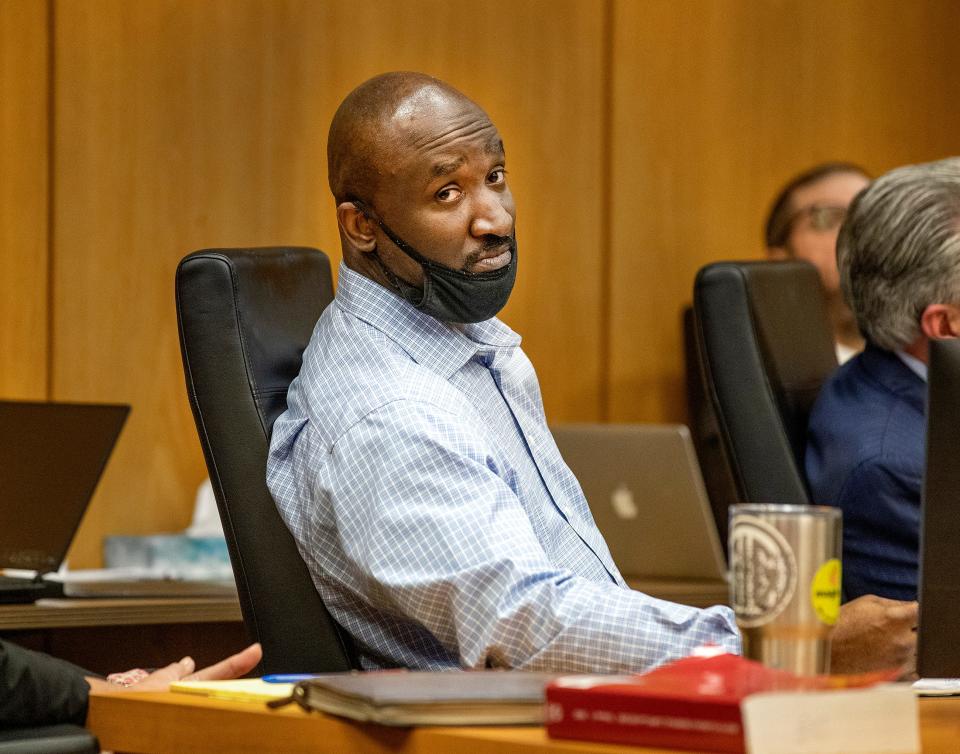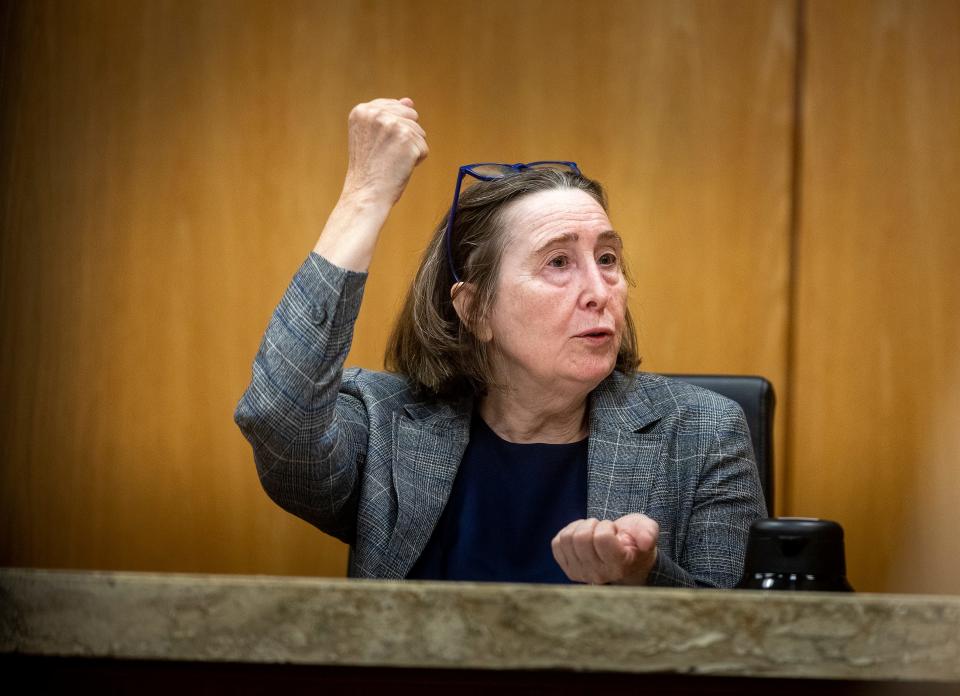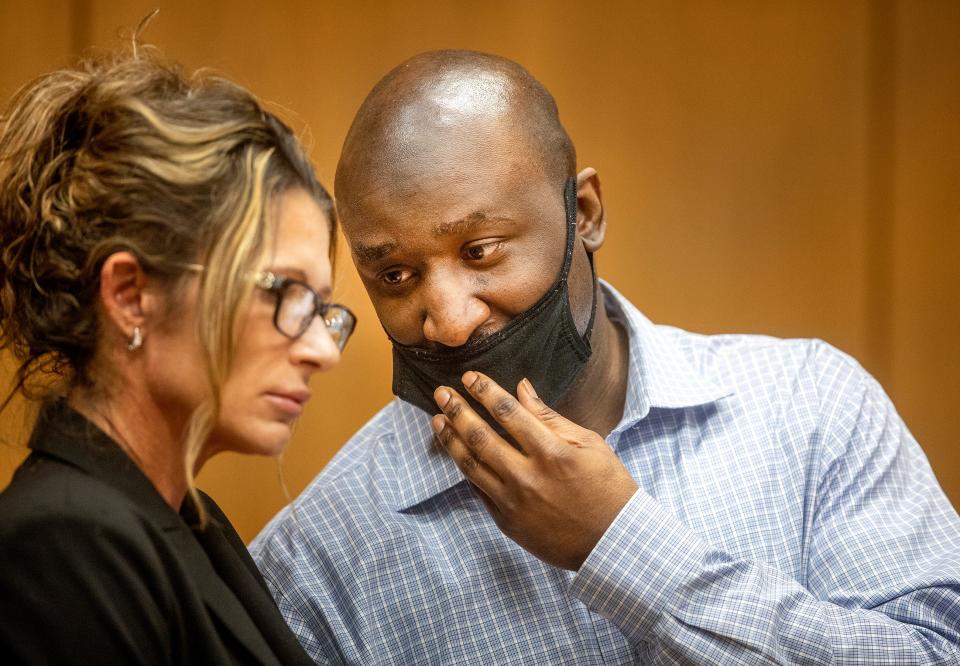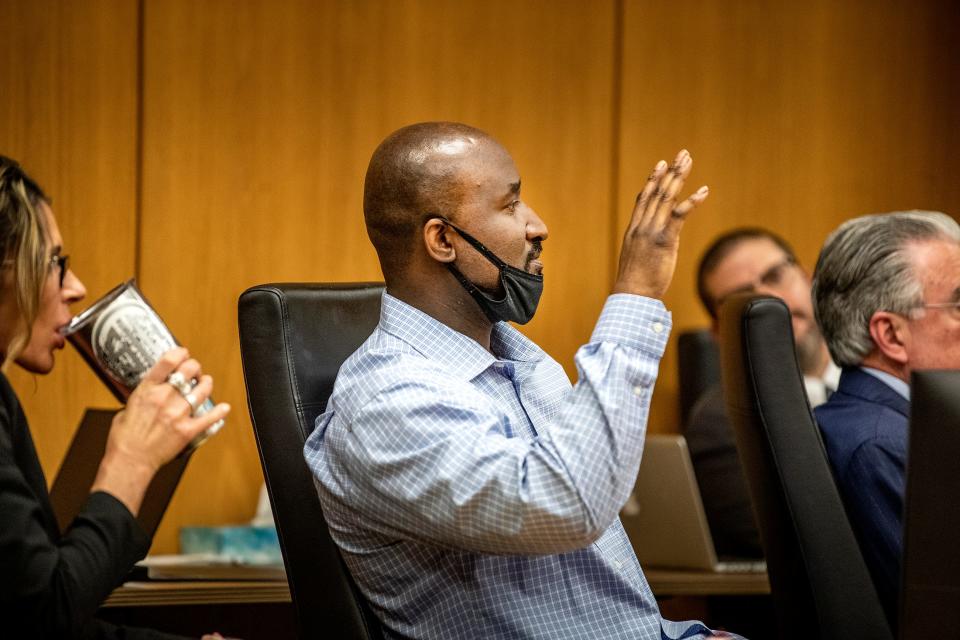Pathologist describes horrific wounds in Lake Morton slayings as prosecution, defense rest
The prosecution rested its case against Marcelle Jerrill Waldon on Tuesday morning at his first-degree murder trial in the 2020 Lake Morton slayings of a former Lakeland city commissioner and her husband.
The prosecution, Waldon's defense attorneys and the judge spent the remainder of Tuesday in court finalizing instructions the jury will follow as they deliberate on a long list of charges against him.
Waldon is on trial in Bartow on two first-degree murder charges in the stabbing deaths of Edie Yates Henderson and David Henderson in their Lake Morton home.
He faces a slew of other charges. Prosecutors allege he stole jewelry before killing the Hendersons, then tried to to cover up the crimes by attempting to burn down the home and torching a car that was stolen from the couple.
Items missing from the Hendersons included, jewelry, credit cards, bank checks and the husband’s Audi A6.

Prosecutors are seeking the death penalty if Waldon is found guilty.
Testimony concluded Tuesday as the prosecution and defense called their last witnesses to the stand. Waldon decided not to testify during a brief discussion with Circuit Judge J. Kevin Abdoney.
'She basically died of the blood loss'
Forensic pathologist Vera Volnikh had performed the autopsies on the two victims. She was the last of the prosecution’s witnesses.
Assistant State Attorney Michael Nutter displayed the autopsy photos of the external and internal injuries to the Hendersons bodies for the jury to see and for Volnikh to use in explaining the cause and manner of death, among other grim details.
This was the third time evidence was presented about the very bloody crime scene to the jury. First-responding police officers and crime-scene technicians also described encountering the bodies. As was the demeanor of the jurors the other times, many appeared emotional as the images were shown.
In all, Edie Henderson had suffered seven stab wounds and four incisor wounds, which were not as deep as the stab wounds, Volnikh said.
On the left side of her torso, she suffered a cluster of five wounds, including two perforations to her left lung, two perforations to her heart and one perforation to her aorta, Volnikh said. The knife had to pass through bones within the rib cage to reach some of the internal organs.
“She basically died of the blood loss,” Volnikh said. She added that the amount of blood loss would have meant brain death in about 10 minutes after suffering the stab wounds.
“Are the injuries consistent with a kitchen knife?” Nutter asked the expert.
“Yes,” she said. “They are consistent with a kitchen knife.”
She added that contusions around her wrist were suffered while she was still alive because of the color of the injury. Edie Henderson’s body had been found with a belt around her ankles and a tie was found tied to a lamp on the nightstand.
Further, a stab wound on her shoulder injured her trachea making it difficult for her to breath and talk.
Ultimately, she said the death was a homicide.
“She died at the hands of another,” Volnikh said.
Nearly all the stab wounds to David Henderson were in his back, including one in his neck that severed his spine and would have made the victim fall over as nerves between his brain and legs were disconnected, she said.

“Here we have most of the wounds on the back,” she said, using a pointer to show the jury.
He also lost a lot of blood, she said. The husband suffered nine stab wounds and three incisor wounds. Seven of the stab wounds were to his back. His aorta and both lungs were perforated.
One wound to his head was much wider than deep, she said. “The skull stopped that knife.”
“He died mostly of bleeding,” Volnikh said. She added, his death was also determined to be a homicide.
While the autopsy photos were displayed, Nutter asked several times whether the stab wounds would have required significant force and violence, and she affirmed both.
Time of death: 'Nobody knows'
Waldon’s defense attorney, Debra Toumey, pushed back on the forensic pathologist’s evidence and testimony, asking if she knew the time of death.
“Nobody knows,” Volnikh said. The time the bodies were found were used for the time of death. The pathologist added the bodies showed no signs of decomposition, so the deaths had to have occurred less than 48 hours before they were found.
Further, Tuomey asked whether Volnikh knew what kind of knife was used in the deaths.

“I don’t know what kind of knife,” she said. “It’s most likely the knife. Which knife, I don’t know.”
In an effort to match her findings to the missing knife from the Hendersons' kitchen butcher block, Nutter asked Volnikh about the depth of the wounds and whether they about 15 centimeters, which is about the length of the blade on the missing knife from the Hendersons' butcher block.
She said they were, which is about four to five inches in length.
Following Volnikh’s testimony, the prosecution rested its case.
Before she had taken the stand, the prosecution and defense had asked the judge to rule on which autopsy photos the jury would see, and he accepted the majority into evidence.
Nutter argued that many of the photos the defense had objected to demonstrated the force and violence of the defendant’s actions as well as the intent and premeditation of the Hendersons’ killer.
Motion to dismiss
There was also a short hearing on a motion by the defense to dismiss the charges against Waldon because of a lack of evidence. Tuomey repeated many of the points she raised with witnesses earlier in the trial to poke holes in the prosecutions evidence.
Regarding the photos of the crime scene, including the victims’ bodies that were found on Waldon’s cell phone, she said her client and Jarvis Collins, who testified he helped Waldon try to pawn jewelry after the killings, both used each other's phones. She said that means the state had not proved her client was the photographer.
Further, she said the prosecutors did not prove her client was inside the house, among many other reasons for dismissing all the charges.
But Nutter rebutted, saying Waldon was in possession of items taken from the home, including the bank card found in a red Nike drawstring bag with Edie Henderson’s and Waldon’s DNA on it, he said.
Multiple witnesses had placed the defendant in the vicinity of the crime scene around the time the killings took place, Nutter said.
Tuomey doubled down on his response, saying there was no evidence, no DNA nor fingerprints at the site of the murders to tie Waldon to the deaths. She described the events surrounding the deaths as an “orchestrated crime spree organized by others.”
Abdoney did dismiss the forgery charge, in which the state attorney alleged he had tried to cash a $5,000 check belonging to the Hendersons, but the judge left the 10 remaining charges intact for the jury to decide.
A short defense: Two witnesses
Waldon's attorneys mounted a brief defense after the hearing, calling two witnesses.
They called the proprietor of Brown’s jewelry store in Plant City, visited by Collins on Nov. 11 – the day after the killings – as Waldon slept in the back seat of Roderick Burgess’ car.

Russell Brown identified Collins as the individual who tried to sell the Hendersons' jewelry at the store.
Collins told him the jewelry was his mother’s and she needed help so he was selling it for her, Brown said. He also did not have enough cash on hand to purchase such expensive jewelry.
He said he overheard Collins' conversation on the cell phone as he paced inside and outside of the store. Eventually he came to realize the jewelry was not his.
“By law, we’re not allowed to buy someone else's jewelry,” Brown said.
The other witness was Tammy Hathcock, a detective with the Lakeland Police Department, who had also testified for the prosecution.
Tuomey asked whether Hathcock had found a pair of Fila tennis shoes at the Hendersons' house.
Lake Wales: Doctor charged with secretly recording female teenage patient as she changed
Hathcock said they were collected as evidence and another individual was interviewed in connection with the shoes but after the possible evidence was tested by FDLE, the crime lab’s report did not provide cause to investigate the other individual further.
The testimony ended at about 11:30 a.m. Tuesday, so Abdoney let the 12 jurors and one alternate go home early.
The prosecution and defense are expected to give closing arguments on Wednesday, and the jury could be given instructions.
This article originally appeared on The Ledger: Pathologist describes violent deaths in Lake Morton slayings

